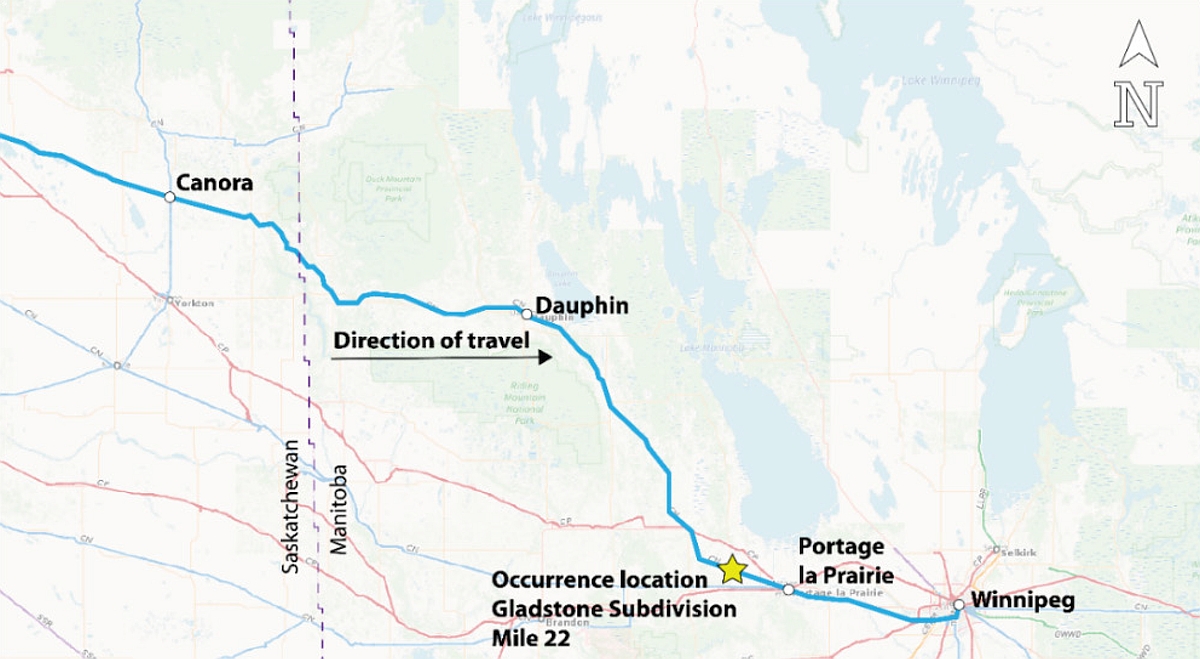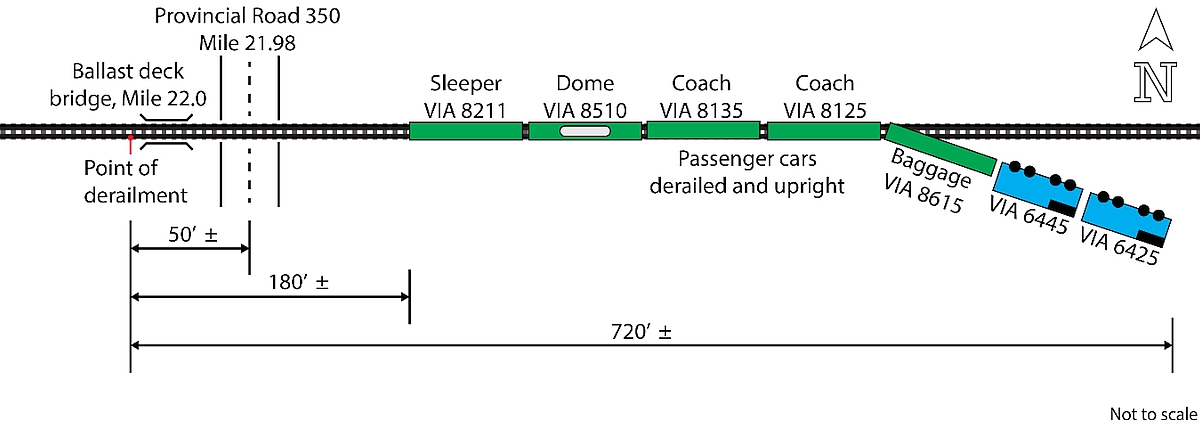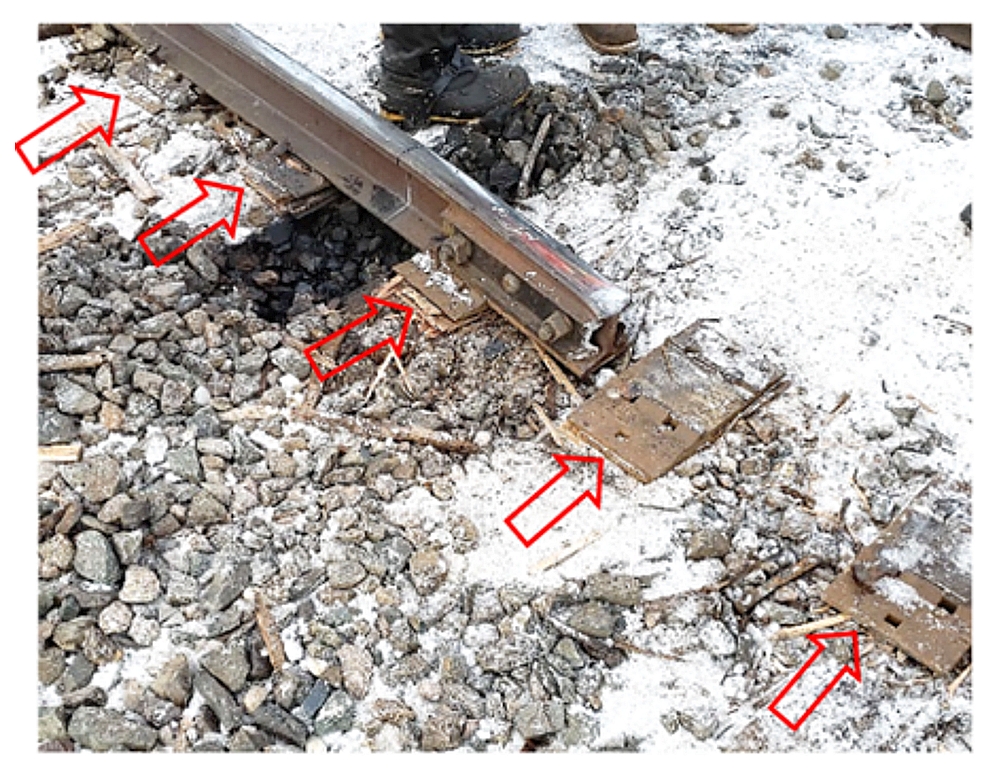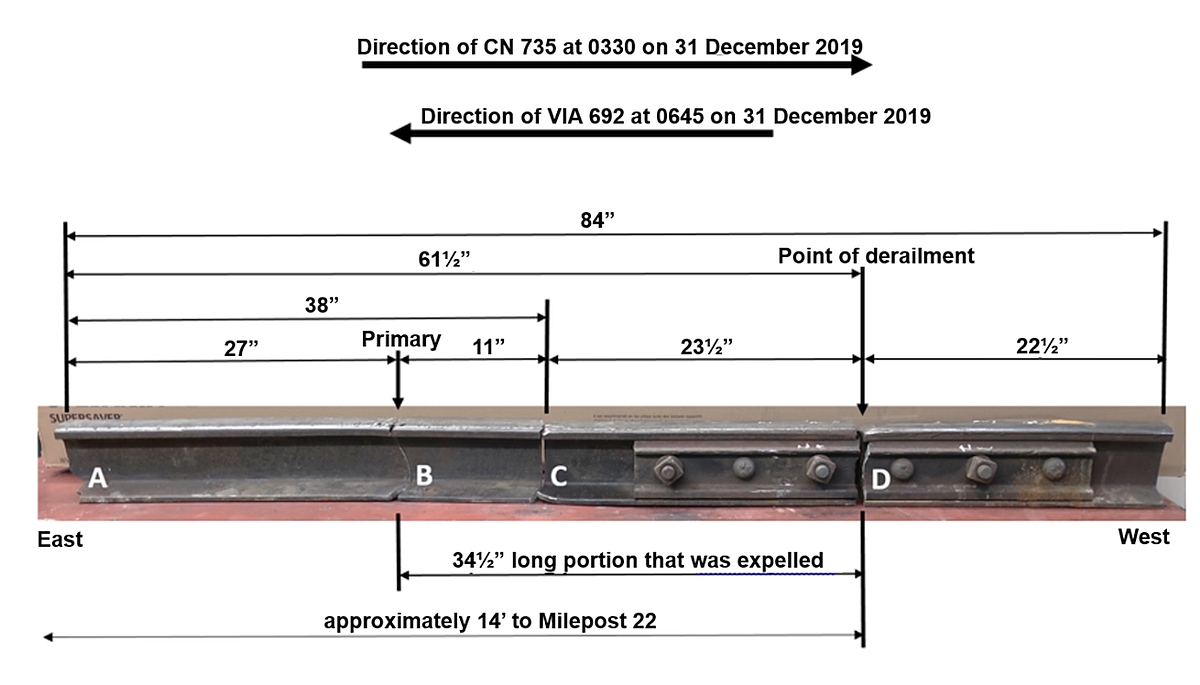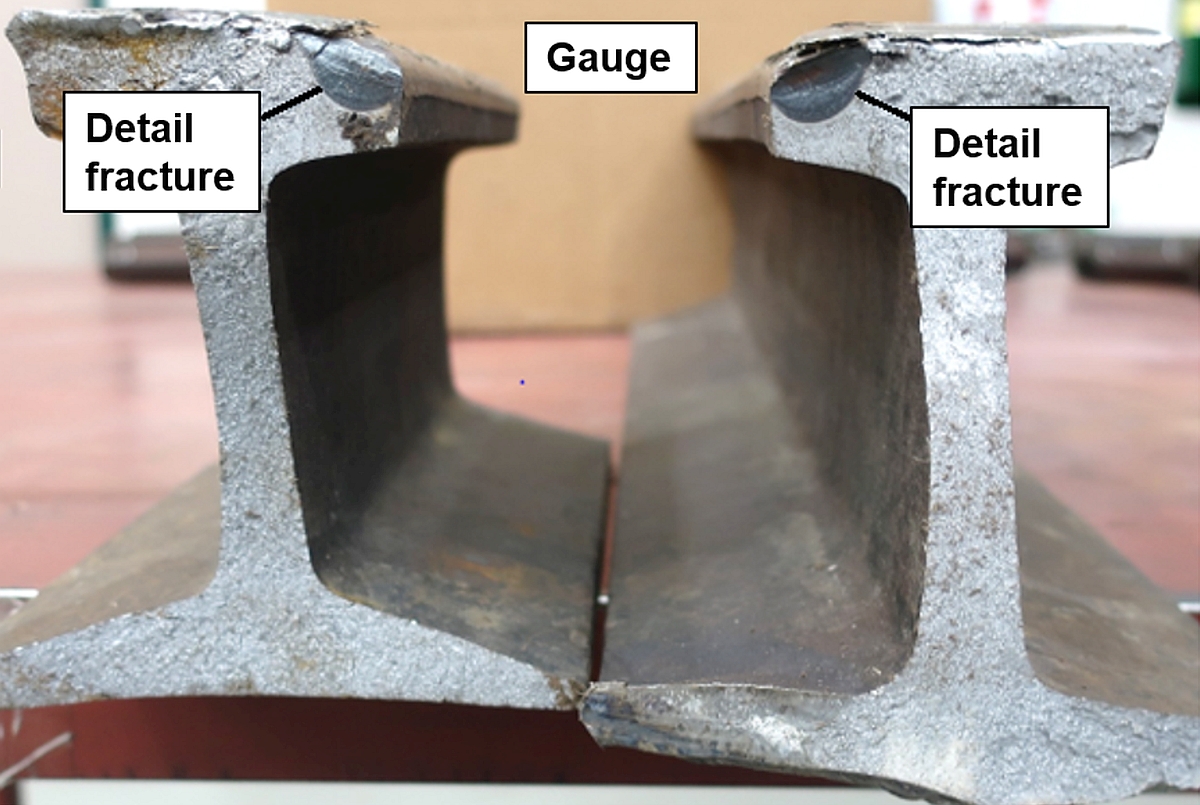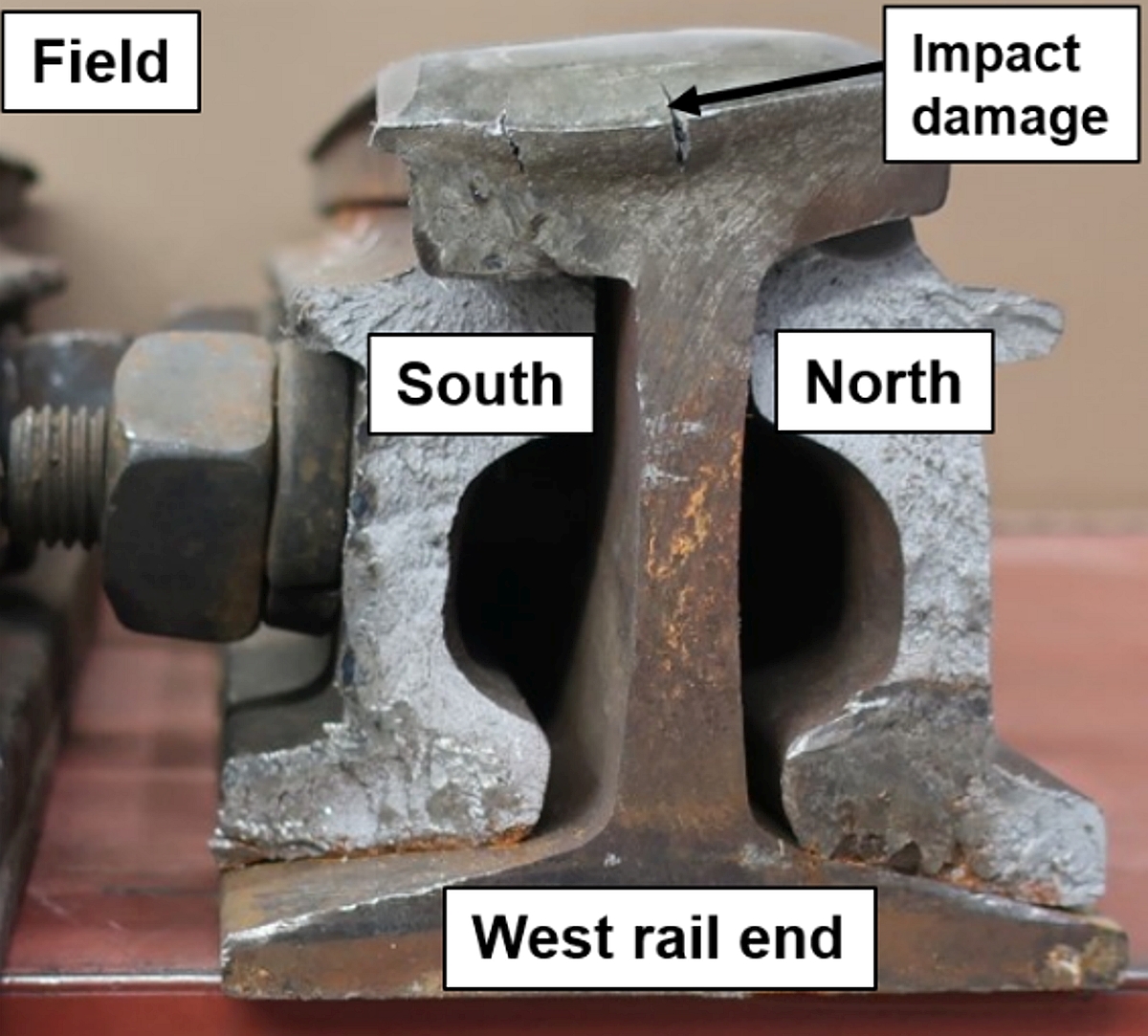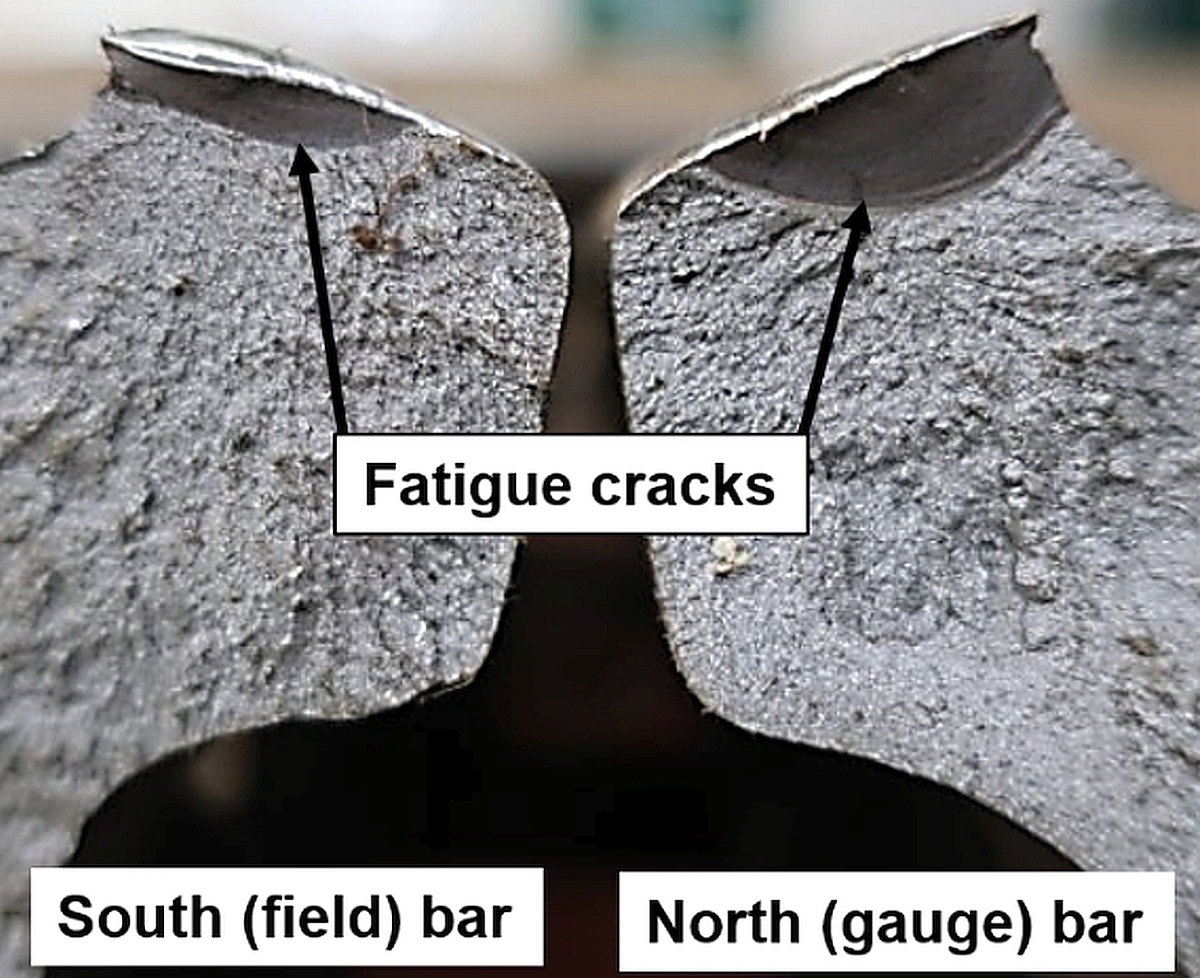Main-track derailment
VIA Rail Canada Inc.
Passenger Train 692
Mile 22, CN Gladstone Subdivision
Katrime, Manitoba
The Transportation Safety Board of Canada (TSB) investigated this occurrence for the purpose of advancing transportation safety. It is not the function of the Board to assign fault or determine civil or criminal liability. This report is not created for use in the context of legal, disciplinary or other proceedings. See Ownership and use of content. Masculine pronouns and position titles may be used to signify all genders to comply with the Canadian Transportation Accident Investigation and Safety Board Act (S.C. 1989, c. 3).
The occurrence
On 30 December 2019, a VIA Rail Canada Inc. (VIA) operating crew was ordered at 2345Footnote 1 in Canora, Saskatchewan, for VIA passenger train 692 (VIA 692). The eastbound train was to operate from Canora, located at Mile 124.9 of the Canadian National Railway Company (CN) Togo Subdivision, to Winnipeg, Manitoba, located at Mile 0.0 of the CN Rivers Subdivision. At 0016 on 31 December 2019, the train departed Canora.
VIA 692 consisted of 2 head-end locomotives (VIA 6425 and VIA 6445), 1 baggage car, 2 passenger coaches, 1 dome/dining car and 1 sleeper car. The train weighed about 560 tons and was 537 feet long. The VIA operating crew consisted of 2 locomotive engineers (LEs)—an operating LE and an in-charge LE who has duties similar to a conductor. There were also 3 members of VIA’s on-board service personnel and 8 passengers throughout the cars. The VIA operating crew members were qualified for their positions, met fitness and rest requirements, and were familiar with the territory.
At 0645, while proceeding eastward at about 60 mph near Mile 22 of the CN Gladstone Subdivision, VIA 692 experienced a train-initiated emergency brake application, and derailed just west of a short bridge, as it traversed the Provincial Road 350 passive public crossing (Figure 1).
There were 5 minor injuries reported: 2 passengers, the 2 VIA LEs, and 1 member of the on-board service personnel were transported to hospital for evaluation and released the same day.
The temperature at the time of derailment was −12° C.
About 3 hours before the arrival of VIA 692, CN crude oil unit train U73581-30 (CN 735), which was empty, had traversed the area of the derailment, travelling westbound. Wheel impact load detector (WILD) records for CN 735 were reviewed and there were no recorded wheel impacts that exceeded the Association of American Railroad’s or CN’s WILD thresholds.
Site examination
Marks observed on the ground indicated that all cars and locomotives on VIA 692 abruptly derailed to the south side of the track and stopped on the east side of the crossing. The 2 locomotives came to rest on their side while the 5 other cars remained upright (Figure 2).
There were no wheel marks on the track infrastructure leading up to the initial point of derailment, which was located at a broken joint in the south rail, on the west approach to the bridge.
The broken joint was located at the east end of a 22-foot-long plug rail that had been installed in the south rail on 10 March 2019. Several tie plates under the joint had plywood shimsFootnote 2 that appeared to have been recently installed (Figure 3).
A 61½-inch-long section of the south rail, which contained the east end of the failed joint, was recovered from the site. The gauge-corner surface of the rail exhibited checking, intermittent spalling and heavy flaking, conditions which are known to potentially mask the presence of internal rail head gauge-corner defects.Footnote 3 An additional 22½-inch-long section of the south rail, which contained the west end of the failed joint, was also removed from the track. The 2 sections of rail (measuring a total of 84 inches) were subjected to detailed examination by the TSB.
Although the locomotive fuel tanks were not punctured, when the locomotives came to rest on their side, the fuel tank filler caps and overfill lines were compromised. Subsequently, 3887 litres of diesel fuel were released from the fuel tank of VIA 6425 and 4783 litres from the fuel tank of VIA 6445.
Subdivision information
The CN Gladstone Subdivision is a secondary main trackFootnote 4 that extends from Kearns, Manitoba (Mile 0.0), to Dauphin, Manitoba (Mile 121.7). Train movements are controlled by the occupancy control system (OCS) as authorized by the Canadian Rail Operating Rules (CROR), and supervised by a CN rail traffic controller located in Edmonton, Alberta. OCS territory is not equipped with wayside signal systems or associated track circuits to govern movements. Such wayside signal systems are known to aid in the detection of broken rails before the arrival of a train.
In the vicinity of the derailment, the single main track was classified as Class 3, according to the Transport Canada–approved Rules Respecting Track Safety, otherwise known as the Track Safety Rules (TSR). The authorized speed for freight and passenger trains in the area was 40 and 60 mph, respectively. Train traffic consisted of about 4 trains per day with an annual average tonnage of 8.9 million gross tons per mile.
Track information
The track was relatively flat and tangent. The track structure consisted of 100-pound continuous welded rail manufactured by Algoma in 1948. The rail was set into 11-inch double-shouldered tie plates, secured with 3 spikes per plate and box-anchored every other tie. The hardwood ties were generally in good condition with an average of 5 defective ties per 100 feet. The ballast consisted of crushed rock, the cribs were full and the shoulders extended 14 inches beyond the end of the ties.
The TSR outline minimum maintenance standards and track inspection requirements. In addition to the TSR, CN also uses its Engineering Track Standards (ETS), which meet or exceed the TSR requirements. The track was maintained, and all required track inspections were performed, in accordance with the TSR and CN’s ETS.
Track maintenance
The following work and/or inspections were performed in the vicinity of the derailment:
- On 12 October 2019, the rail heads were ground but the full rail head profile was not restored.
- On 15 October 2019, a track inspection was conducted with a CN heavy track geometry car. The brush chart identified several rail profile 62 surfaceFootnote 5 conditions near Mile 22. However, the conditions were below the TSR’s and CN’s ETS urgent defect limits (maximum of 1¼ inches) and did not require immediate attention.
- On 27 October 2019, a rail flaw ultrasonic inspection was performed with no defects noted.Footnote 6
- On 19 November 2019, a track geometry inspection was conducted with a heavy truck–mounted Holland TrackSTAR track geometry test system.Footnote 7 Although there was no record of any track maintenance done in the area between 15 October 2019 and 19 November 2019, the inspection did not show the rail profile 62 surface conditions that were previously identified. This is not uncommon as truck-mounted rail geometry measurement systems such as the Holland TrackSTAR are less sensitive to surface conditions than conventional heavy track geometry cars.
- On 16 December 2019, a vehicle track interaction (V/TI)Footnote 8 cross-level exceptionFootnote 9 of ¼ inch was identified in the south rail, in an area between the joint and the crossing. A track maintenance crew added plywood shimsFootnote 10 under the tie plates to correct the condition.
- On 30 December 2019, a V/TI cross-level exception was identified in the area of the joint in the south rail. A track maintenance crew responded and found the joint suspended ½ inch above the tie plates. Plywood shims were added to correct the condition.
As a result of the cross-level conditions in the area of the derailment, the east joint of the plug rail would have been subjected to vertical displacement and cyclic impact loading with the passage of each train. Such loading is known to accelerate the growth of any cracks that may be present in the rail or the joint bars.
Examination of the rail and joint
The head of the 71-year-old rail was worn, but within allowable limits. The 84 inches of the south rail that were recovered, which included the failed joint, consisted of 4 mating pieces measuring 27 inches, 11 inches, 23½ inches and 22½ inches long respectively from east to west. The pieces were labelled A through D (Figure 4).
Rail break A was catastrophic and occurred as a result of the derailment. The fracture surfaces of rail breaks B and C, located 27 inches and 38 inches from the east end of the rail section respectively, displayed gauge-side rail head detail fractures (DFs).
The DFs observed on rail breaks B (Figure 5) and C were dark with well-defined fatigue fracture characteristics, indicating that they had both been present for some time. The rail break B DF measured about 5/8 inch deep by ¾ inch wide, which accounted for 15% of rail head cross-section. The rail break C DF measured about ¼ inch deep by ¾ inch wide, which accounted for 5% of rail head cross-section. Impact marks on the running surface of the west end of rail break C were consistent with a westward movement (i.e. CN 735).
Broken joint D was located 61½ inches from the east end of the rail section. The joint bars were properly applied and the joint was tight. Both joint bars had broken in two near their mid-point.
The exposed fracture surfaces of joint D displayed pre-existing fatigue cracks in the top surface of the joint bars that fit the radius between the rail head and web. Although joint bar cracks typically occur in these locations, they are very difficult to detect by visual examination. The west-end rail exhibited heavy impact damage that was also consistent with a westbound movement (CN 735) (Figures 6 and 7).
In each of the 3 failures (rail breaks B and C, as well as broken joint D), brittle fractures had developed from the extremities of the pre-existing fractures and propagated through the remainder of the cross-sections. The pre-existing rail head DFs and joint bar fatigue cracks acted as stress risers and facilitated the initiation of brittle through fractures in the south rail and joint bars, respectively.
The observed pattern of the rail head impact damage indicated that the rail and joint bar failures likely occurred under westbound CN 735. The failures (breaks B, C, and D) occurred progressively and led to the expulsion of a section of the south rail, creating a gap of 34½ inches as CN 735 traversed and exited the area. The next train, eastbound VIA 692, could not bridge the gap and immediately derailed to the south side of the track at the west end of the failed joint.
Forward-facing locomotive video recorders
Westbound CN 735 traversed the occurrence site at 0330. A review of the head-end locomotive forward-facing video from CN 735 revealed that the rails were intact.
A review of the head-end locomotive forward-facing video from VIA 692 revealed an anomaly positioned next to the gauge side of the north rail at the west approach to the bridge. The anomaly was likely a piece of the south rail that had been expelled during the passage of CN 735.
Other similar occurrences
Since 2014, the TSB has conducted 4 other investigationsFootnote 11 involving track geometry surface defects or conditions that required monitoring and/or temporary repair. In each of these occurrences, the rail failed before becoming an actionable defect or being properly repaired, and caused a derailment.
Safety action taken
On 06 January 2020, CN expanded section 1.2 (Joints) of its ETS whereby additional inspections and preventative maintenance measures are now required whenever work is being conducted in the vicinity of a joint. The additional measures are:
- Whenever work is being performed at or near a joint, the joint bars must be inspected for cracks, the bolts must be tightened and the low joints must be tamped or shimmed.
- Any joint bar found to be cracked or broken, outside of the middle bolt holes in Class 3 track and above, must be replaced.
- When replacing a cracked bar, closely inspect the matching bar for cracks and replace if needed.
This report concludes the Transportation Safety Board of Canada’s investigation into this occurrence. The Board authorized the release of this report on . It was officially released on .
